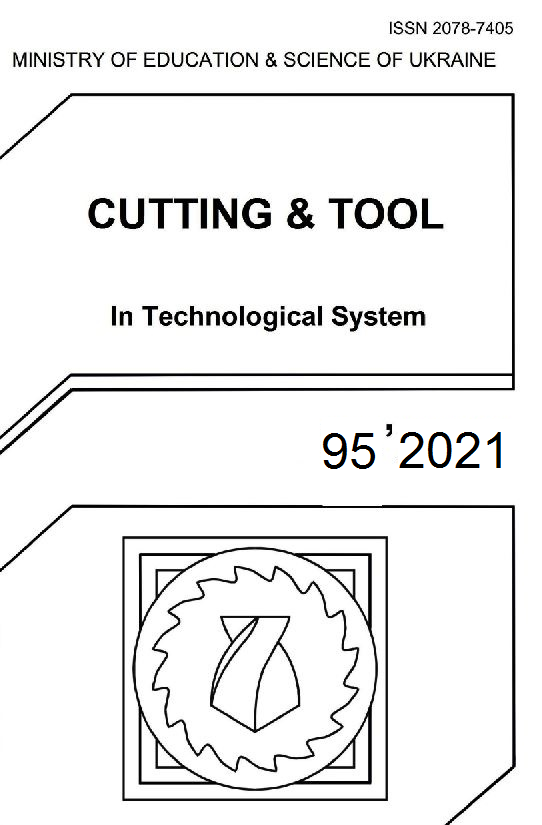RESEARCH OF THE CUTTING MECHANISM AT ELECTRICAL DISCHARGE GRINDING
DOI:
https://doi.org/10.20998/2078-7405.2021.95.05Abstract
The paper presents the results of a study of the cutting mechanism during electrical discharge grinding of hard alloys. The cutting mechanism during electrical discharge grinding was studied using mathematical modeling. By means of geometric modeling, a method of grinding cup wear was developed. The functional dependence of the diamonds use factor in the Kw wheel on the technological parameters of processing, wear and tool characteristics were determined. Analysis of the results of the study shows that an increase in efficiency at electrical discharge grinding can be achieved by reducing the wear of S, and by corresponding variation in the concentration of diamonds and technological modes of processing.
References
Strelchuk, R., Shelkovyi, O.: Optimization of the Interelectrode Gap in Electrical Discharge Grinding with Changing Electrode Polarity. Lect. Notes Mech. Eng. 143–152 (2021). https://doi.org/10.1007/978-3-030-77719-7_15.
Strelchuk, R., Trokhymchuk, S., Sofronova, M., Osipova, T.: Revealing patterns in the wear of profile diamond wheels. Eastern-European J. Enterp. Technol. 3, 30–37 (2020). https://doi.org/10.15587/1729-4061.2020.203685.
Strelchuk, R.: Investigation of the Removal of the Diamond Layer of a Wheel During Ed Grinding with Changing Polarity of Electrodes. Ann. „Constantin Brancusi” Univ. Targu Jiu, Eng. Ser. 45–49 (2021).
Gupta, A., Kumar, H.: Optimization of EDM Process Parameters: A Review of Technique, Process, and Outcome. In: Lecture Notes in Mechanical Engineering. pp. 981–996. Springer Science and Business Media Deutschland GmbH (2021). https://doi.org/10.1007/978-981-15-8542-5_87.
Strelchuk, R.M., Trokhimchuk, S.M.: Mathematical modeling of the surface roughness of the grinding wheel during straightening. Nauk. Visnyk Natsionalnoho Hirnychoho Universytetu. 53–59 (2021). https://doi.org/10.33271/nvngu/2021-1/053.
Alsigar, M., Pereverzev, P., Almawash, A., Alkadhim, M.: Optimal design of grinding systems with use of mathematical complex models ECGA. In: Materials Today: Proceedings. pp. 1521–1525. Elsevier Ltd (2021). https://doi.org/10.1016/j.matpr.2020.08.142.
Lavrinenko, V.I., Ilnitskaya, G.D., Petasyuk, G.A., Ishchenko, E. V., Gaidai, S. V., Pasichnyi, O.O., Skryabin, V. V., Shatokhin, V. V., Zaitseva, I.N., Kuz’menko, E.F., Timoshenko, V. V.: A Study of the Potential of Improving Performance of AS20 Diamond Powders Through Altering Their Dimensional and Physico-Chemical Characteristics. J. Superhard Mater. 40, 274–281 (2018). https://doi.org/10.3103/S106345761804007X.
Zhang, Y., Li, C., Ji, H., Yang, X., Yang, M., Jia, D., Zhang, X., Li, R., Wang, J.: Analysis of grinding mechanics and improved predictive force model based on material-removal and plastic-stacking mechanisms. Int. J. Mach. Tools Manuf. 122, 81–97 (2017). https://doi.org/10.1016/j.ijmachtools.2017.06.002.
Wen, X., Cheng, J.: Experimental study of a specially designed diamond micro discontinuous grinding tool. Int. J. Adv. Manuf. Technol. 102, 3341–3356 (2019). https://doi.org/10.1007/s00170-019-03333-w.
Downloads
Published
Issue
Section
License
Copyright Notice
Authors who publish with this Collection agree to the following terms:
1. Authors retain copyright and grant the Collection right of first publication with the work simultaneously licensed under a Creative Commons Attribution License that allows others to share the work with an acknowledgement of the work's authorship and initial publication in this Collection.
2. Authors are able to enter into separate, additional contractual arrangements for the non-exclusive distribution of the Collection's published version of the work (e.g., post it to an institutional repository or publish it in a book), with an acknowledgement of its initial publication in this Collection.
3. Authors are permitted and encouraged to post their work online (e.g., in institutional repositories or on their website) prior to and during the submission process, as it can lead to productive exchanges, as well as earlier and greater citation of published work.

